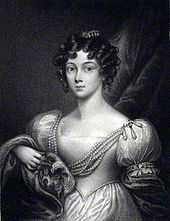Barbara Rawdon-Hastings, Marchioness of Hastings

Barbara Rawdon Hastings, born Barbara Yelverton (20 May 1810 – 18 November 1858), suo jure 20th Baroness Grey de Ruthyn, by marriage Marchioness of Hastings, was a fossil collector and geological author.
Early life
Born at Brandon House, Warwickshire, Barbara Yelverton was the only child of Henry Yelverton, 19th Baron Grey de Ruthyn (1780–1810), and of his wife Anna Maria Kelham (1792–1875). At seven months, her father's death made her Baroness Grey de Ruthyn. Little is known of her early life or education.[1]
Personal life
On 1 August 1831, Lady Grey de Ruthyn married George Rawdon-Hastings, 2nd Marquess of Hastings (1808–1844), and they had six children together. On 9 April 1845, fifteen months after her first husband's death, she married secondly Captain Hastings Reginald Henry RN (1808–1878), who in 1849 took the name of Yelverton by royal licence. They settled at Efford House near Lymington and had one daughter, Barbara Yelverton (12 January 1849 – 1 October 1924), who married John Yarde-Buller, 2nd Baron Churston[1][2]
During her first marriage, Lady Hastings was nicknamed 'the jolly fast marchioness', as she was fond of foreign travel and gambling.[1]
Fossil collector and geologist

Lady Hastings was an avid collector of fossils, specializing in vertebrates. Since 1855 her collection has been housed in the British Museum, containing specimes found in Europe. The palaeontologist and anatomist Professor Richard Owen wrote of the thousands of fossils previously in her private museum at Efford House, among them "some of the finest in the world".[3] Her knowledge of local geology, especially of the Eocene, and her meticulous work on fossil remains, gave her an expertise which was respected by scholars. Lady Hastings associated with many eminent scientists during her lifetime, including Edward Forbes, Charles Lyell, Alexander Falconer, William Buckland and Richard Owen. The geologist Forbes referred to her as a 'fossilist' and acknowledged her work.[4] Sixty-four of her letters to and from Owen are preserved in the Natural History Museum's Richard Owen Collection.[5]
Owen preposed to name her discovered crocodile fossil, recovered from the Barton Beds at Hordle Cliff in Hampshire Crocodilus hastingsae to honour "the accomplished lady by whom the singularly perfect example of the species had been recovered and restored".[1]
In 1847, Lady Hastings presented her paper to the Oxford meeting of the British Association for the Advancement of Science, exhibiting two crocodile skulls and the shell of a turtle from Hordle Cliff.She argued that crocodile remains found on the Hampshire coast and also on the Isle of Wight showed that the area of the Solent had been a freshwater river or lake.[1] Immediately after Richard Owen explained that the remains from Hordle suggested "a new genus of Pachyderm", which he named Paloplotherium, falling between Palaeotherium and Anoplotherium, during his presentation of the same fossils.[1]
In 1852 and 1853 she published papers on the stratigraphy of Hordle Cliff (which she called the Hordwell cliff), the first such accurate accounts of it. She stated that her goal was to provide local information from which a comprehensive account of Tertiary stratigraphy could be created.[6] In 1858 she died in Rome and is buried there.
Bibliography
- Owen, R. S., 'On the fossils obtained by the marchioness of Hastings from the freshwater Eocene beds of Hordle cliff', in Report of the British Association for the Advancement of Science (1848), pp. 65–6
- Hastings, B., 'On the freshwater Eocene beds of Hordle cliff, Hampshire', in Report of the British Association for the Advancement of Science (1848), pp 63–64
- Hastings, Marchioness of, 'On the Tertiary beds of Hordwell, Hampshire', in London, Edinburgh, and Dublin Philosophical Magazine, 4th series, 6 (1853), pp. 1–10
References
- ↑ 1.0 1.1 1.2 1.3 1.4 1.5 Dadley, Portia, Hastings, Barbara Rawdon [née Barbara Yelverton], marchioness of Hastings and suo jure Baroness Grey de Ruthin (1810–1858), fossil collector and geological author in Oxford Dictionary of National Biography (Oxford University Press, 2004)
- ↑ "thePeerage.com". Archived from the original on 17 May 2008. Retrieved 2008-05-06.
- ↑ Owen, R., The Life of Richard Owen, vol. 1 (1894) p. 296
- ↑ Wilson, G., Geikie, A., A Memoir of Edward Forbes, F.R.S., late regius professor of natural history in the University of Edinburgh (1861), p. 423
- ↑ Ogilvie, Marilyn (2000). Harvey, Joy, ed. The biographical dictionary of women in science : pioneering lives from ancient times to the mid-20th century. New York, NY [u.a.]: Routledge. ISBN 0-415-92039-6.
- ↑ Hastings, Marchioness of, 'On the Tertiary beds of Hordwell, Hampshire' in Philosophical Magazine, 4th series (1853)
| Peerage of England | ||
|---|---|---|
| Preceded by Henry Yelverton |
Baroness Grey de Ruthyn 1810–1858 |
Succeeded by Henry Rawdon-Hastings |
|